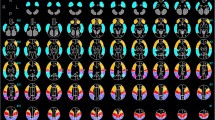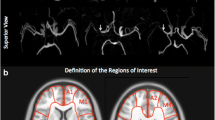Abstract
Cerebral rCBF, rOEF, rCMRO2, and rCBV in moyamoya disease were studied by means of positron emmission tomography (PET), using 15O as a tracer. Steady-state methods with C15O2 and 15O2 were used to obtain the functional images of rCBF, rCMRO2, and rOEF. The 15O single-inhalation method was used to obtain the rCBV image. Five children (two boys and three girls) with mean age of 11 years and eight normal volunteers with mean age of 31 years were included in the study. The symptoms of moyamoya disease were due to cerebral ischemia, such as transient ischemic attack (TIA), reversible ischemic neurological deficit (RIND), and minor stroke. The interval between the latest ictus and PET scan ranged from 3 days to 3 years 6 months. Physiological parameters (rCBF, rCMRO2 etc.) in cerebral gray matter, cerebral white matter and basal ganglia were calculated from the single functional images. Any, low density areas appearing in X-ray-CT performed just prior to the PET study were carefully excluded from the analysis. The parameters of moyamoya disease were statistically compared with normal control parameters. Though the value of rCBF was slightly higher in moyamoya disease, this difference was not statistically significant. On the other hand, in moyamoya disease rCBV increased significantly in gray matter, white matter, and basal ganglia. The ratio of CBF to CBV is considered to be the index of perfusion pressure and reciprocal of cerebral mean transit time under the normal autoregulation of CBF. This ratio was calculated and compared with the normal value for each tissue. The ratio was significantly decreased in each tissue in moyamoya disease, indicating the presence of a low perfusion pressure in the moyamoya brain. In general, when the reduction of perfusion pressure becomes profound the decrease in the CBF-to-CBV ratio is followed by an increase in rOEF. In spite of the reduction in the CBF-to-CBV ratio there was no significant increase in rOEF in moyamoya disease. Thus, the cerebral circulation in childhood moyamoya disease of ischemic type was characterized by a mild decrease in perfusion pressure and a prolonged circulation time.
Similar content being viewed by others
References
Gibbs J (1983) The relationship of regional cerebral blood flow, blood volume, blood volume and oxygen metabolism in patients with carotid occlusion: evaluation of perfusion reserve. J Cereb Blood Flow Metab 3 [Suppl 1]:590–591
Handa H, Yonekawa Y, Tanada S, Taki W, Kobayashi A, Ishikawa M, Torizuka K (1982) Dynamic CT scan and natural course of children's moyamoya disease. Annual report of study group of occlusive disease of circle of Willis. Japanese Welfare Ministry, Tokyo, pp 89–98
Ketty SS (1956) Human cerebral blood flow and oxygen consumption as related to aging. J Chronic Dis 3:478–486
Lammertsma AA, Hearth D, Jones T (1982) A statistical study of the steady state technique for measuring regional cerebral blood flow and oxygen utilization using 150. J Comput Assist Tomogr 6:566–573
Merlamed E, Lavy S, Bentin S, Cooper G, Rinot Y (1980) Reduction in regional blood flow during normal aging in man. Stroke 11:31–34
Ogawa A, Nakamura N, Sugita K, Sakurai Y, Kayama T, Wada T, Suzuki J (1987) Regional cerebral blood flow in children. Brain Nerve 39:113–118
Paulson O, Lassen NA, Skinhoj E (1970) Regional cerebral bloodflow in apoplexy without arterial occlusion. Neurology (Minneap) 20:125–138
Sakai F, Nakazawa K, Tazaki Y, Ishii K, Igarashi H, Aoki S, Kanada T, Hirose R (1983) Evaluation of human cerebral blood volume and hematocrit with single photon emission computed tomography. J Cereb Blood Flow Metab 3 [Suppl 1]:160–161
Senda M, Tamaki N, Yonekura Y, Tamada S, Murata K, Hayashi N, Fujita J, Saji H, Konishi J, Torizuka K, Ishimatsu K, Takami K, Tanaka E (1985) Performance characteristics of Positologica III: a newly designed whole-body multi-slice positron computed tomograph. J Comput Assist Tomogr 9:940–946
Skinhoj E, Hoedt T, Rasmussen K, Paulson O, Strandgarrd S (1970) Regional cerebral blood flow and its autoregulation in patients with transient focal cerebral ischemic attacks. Neurology (Minneap) 20:485–493
Takeuchi S (1983) Cerebral hemodynamics in patients with moyamoya disease: 1. A study of epicerebral microcirculation by fluoresceine angiography. Neurol Med Chir (Tokyo) 23:711–719
Taki W, Handa H, Yonekawa Y, Sakurai Y, Ito Z, Kawakami K, Kutuzawa H (1985) Cerebral blood volume, blood flow and oxygen utilization in “moyamoya” disease. J Cereb Blood Flow Metab 5 [Suppl 1]:439–440
Uemura K, Yamaguchi K, Kojima S, Kobayashi A, Ishikawa M, Tanada S, Yonekura Y, Senda M, Trizuka K, Fukuyama H, Fujimoto N, Harada K, Kameyama M (1975) Regional cerebral blood flow on cerebrovascular “moyamoya” disease. Study by 133Xe clearance method and cerebral angiography. Brain Nerve 27:385–393
Author information
Authors and Affiliations
Rights and permissions
About this article
Cite this article
Taki, W., Yonekawa, Y., Kobayashi, A. et al. Cerebral circulation and oxygen metabolism in Moyamoya disease of ischemic type in children. Child's Nerv Syst 4, 259–262 (1988). https://doi.org/10.1007/BF00271919
Received:
Issue Date:
DOI: https://doi.org/10.1007/BF00271919




